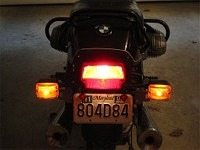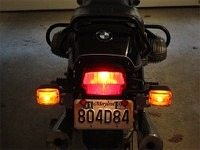Motorcycle LED Brake Light Replacement
In my never-ending search for perfect motorcycle visibility, I happened to come across the website for LEDtronics, a Torrance, California based firm that makes LED’s (light emitting diodes) in just about every shape and size anyone would ever need. I was mulling over the idea of buying a handful of LED’s to enhance the brake light on my 1986 BMW R65 motorcycle when I found the LEDtronics 1156 LED brake light replacement — it is way too expensive, but I just had to give it a try.
I have some LED motorcycle brake light enhancements on my other motorcycle, a ’94 BMW K75, and I’m pleased with the way they’ve been working (see the article “Improving the Brake Light Visibility of a BMW K75” on the wBW Technical Articles page).
LED’s draw very little current; are very bright; they cycle on and off extremely fast compared to incandescent bulbs; and they have a very long service life. This is important for motorcycle applications. They are also much more resistant to failure from vibration, which makes them potentially useful on motorcycles.
The downside is that the LED lights throw light that is very directional. They must be viewed at almost a direct angle in order to realize their increased brightness (more on this later).
By the way, did I say they can be very expensive? The LEDtronics 1156 replacement in red costs $48.50, and it cost me $5.35 for shipping to the east coast via UPS ground. Yep, I’m embarrassed! But hey, at least the money was spent in the spirit of webBikeWorld knowledge sharing….
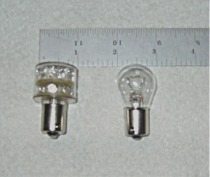
It is apparent (confirmed by other sources) that some lower-quality LED lights from overseas can produce very low levels of light, enough to make them fairly useless for brake light applications.
The owner was pleased with the brightness of the LEDtronics replacement light, and there are some photos on the site that illustrate some of the differences between his stock LED light and the LEDtronics 1157. I was convinced that a lighting replacement would do the same for my R65.
So I eventually ordered an 1156 replacement after communicating with an engineer at LEDtronics about which color light would be appropriate. He assured me that the red LED is the one to use for brake light applications.
The LED light is differently shaped than the 21 watt GE 1156 long life that I use (see photo left), but it fit in the receptacle of the R65’s taillight with no problem. The shape of the LEDtronics light may be an issue on some bikes though — see the dimensions in the schematic above to determine if it will fit for your application.
I was anxious to try out the LED to see what difference it made. I assumed it would be noticeably brighter than the 1156 bulb I was using — I was psyched up and thinking it would blast anyone to the rear with shimmering cascades of brilliant light! But as soon as I applied the brakes, I realized this was not to be.
Although the LEDtronics LED light cycles on very quickly, it was immediately obvious that the amount of light it put out was nowhere near the incandescent. It is much more directional, and it doesn’t have enough “side throw” to bounce the light around in the plastic chrome housing and out the back of the taillight lens.
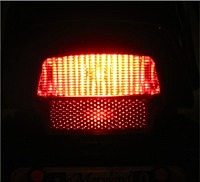 |
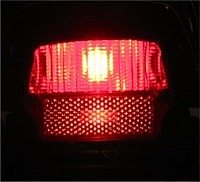 |
|
Photo 2 – 1156 incandescent |
Photo 3 – 1156 LED |
|
|
|
|
Photo 4 – 1156 incandescent |
Photo 5 – 1156 LED |
I took some photos of the light from straight on (Photos 2 and 3) at brake light level and also from looking down at the brake light (Photos 4 and 5), where the directionality is much more noticeable. Both sets of photos were taken from about 5 feet back, and photos 4 and 5 were taken from a camera lens height of 5′ 2″.
It’s hard to get good photos of lighting, but I think you can see that the photos illustrate that the LED light in Photo 3 is much more directional and doesn’t fill up the brake light lens with light when compared to the 1156 incandescent bulb in Photo 2.
I think the reason for this is that out of the 24 individual LED lights that make up the LEDtronics unit, 16 are oriented directly towards the back and only 8 of them are oriented radially around the sides. This limits the amount of light that can be reflected off the chrome light housing.
Photos 4 and 5 compare the lights from above. Again, I think this illustrates what my eye sees — the LED light is more directional and doesn’t throw the same quality and “volume” of light that the incandescent bulb does.
So, the bottom line is this: the only benefit I see of using the LED light in this application is that the light cycles on (and turns off) immediately upon application of the brakes. LEDtronics claims that this can reduce reaction time at 65 mph by 15 feet. But I don’t think the tradeoff in brightness is worth it.
By the way, I have nothing at all against LEDtronics or their claims. They have been honest and they seem to be a decent company to do business with. My opinion is that unless your brake or taillight were specifically engineered for LED lights, the old-fashioned incandescent may still be the way to go. My search continues….
Owner Comments and Feedback
wBW Visitor “JDV” sent this note: “Rick: I stumbled onto (your article) looking for LED replacement lights. Great article on LED’s. I bought them last year and they never worked for me: Running lights would not stay on, and the brake lights would erratically blink. They are now dust collectors on my garage shelf. I tried them on three different bikes and three different result I got, and all three were not the advertised result. I couldn’t tell you if I noticed if they were brighter or not. They just didn’t work for me. When I called (the company that made the LED’s), they told me they were tested before they had them shipped. I asked them if using them on a motorcycle would make a difference; apparently not. They asked me to send them back to them, I never got around to it, giving up on LED. Back to incandescent.”
wBW Visitor “B.W.” wrote us with this information: “I came across your article “LED brake light replacement light”, and noticed the claim that LEDtronics supposedly makes that the instant-on characteristic of an LED can reduce reaction distance at 65 MPH by 15 feet. A little simple arithmetic shows this to be a pretty inflated claim.
A standard incandescent brake light reaches 80% of its full brightness in less than 100 mS; with most lights, a figure of 80 mS is pretty representative.
65 MPH is 95 feet/second. Thus in 80 mS, the bike will have traveled only about 7-1/2 feet, not 15. But even that is an inflated figure since already by the 50 mS mark, a standard brake light will have reached a very significant proportion of full brightness, and will be able to be seen easily. In 50 mS the bike will have traveled less than 5 feet. To me, this is a solution looking for a problem…”
But, visitor “H.M.” has a comment: “Missed point here, IMHO. In a traffic situation, is a sea of incandescent lights, the LED’s catch my eyes first. I’d imagine that if my bike was sporting an array of LED’s and I hit the brakes, the sea of eyes behind me will respond to my lights first. Five feet is five feet. I’ll take any advantage I can get. I’m building my own array of LED’s to flood my Concours tail light with a blinding burst of red stopping power.”
I also still like my LED’s, H.M. How about sending us some photos and a write-up on installing the LED’s on your Concours – that would make a great article that I’m sure would be of interest to others!
Note: For informational use only. All material and photographs are Copyright © webWorld International, LLC – 2000-2011. All rights reserved. See the webBikeWorld® Site Info page. NOTE: Product specifications, features and details may change or differ from our descriptions. Always check before purchasing. Read the Terms and Conditions!



